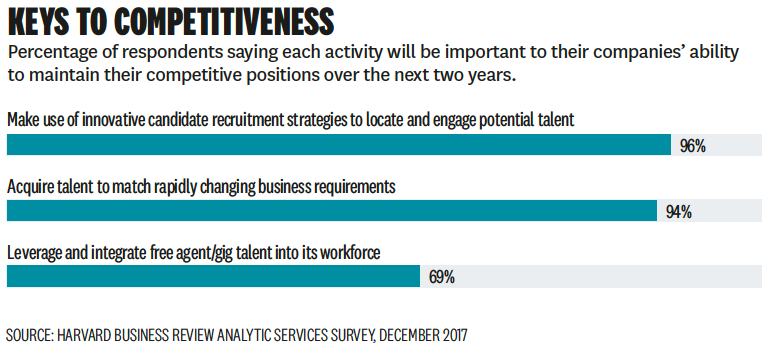Talent Transformation: Technology, Process, and Steps to Stay Ahead

Talent transformation is made possible with the advancements in talent technology, but it’s a mistake to let technology drive that change.
Now don’t get me wrong- We believe that technology enables progress. We built Beamery because we think it’s impossible, in fact, for talent teams to deliver the kind of strategic support expected from them by the larger business organization without a talent operating system like Beamery.
However, we think that transformation can only bring all the value it promises if it starts in the TA team’s strategy, and consequently the processes it designs to deliver on that strategy. It’s just common sense, really: the best results come from identifying the problem you need to solve, then finding the right tools for it, and if needed, building tools for that specific purpose, as opposed to trying to fit existing tools to wholly new problems.
We all agree that enterprises should be paying attention to how the talent acquisition is changing, and should try to stay ahead of that change. The next step is to figure out how to do this; what steps, or rules, or tips companies can keep in mind to not be left behind. Here are a few places to start.
Talent acquisition challenge is now a C-suite focus

CEOs worry a lot more about talent today than they did a few years ago. It might be because the market is a lot tighter and therefore talent supply is more of a constraint on their plans than, say, investment capital or market competition.
It could also be because they’ve come to the realization that, with a little more attention to how they acquire, retain, develop and leverage talent, they could achieve disproportionately positive results. A case of low-hanging fruit that’s been ignored for a while, if you want.
No matter the reason, the result is that CEOs are paying attention to their talent acquisition leaders, or at the very least, they should be. A great place to start transforming as a Talent Acquisition team is to embrace that role.
Embrace this wider scope of responsibility. And to be able to deliver on these increased expectations, take an accordingly wider look at the business. Many companies are dramatically changing how they think about talent at the highest levels of leadership, and you need to be at the forefront of these changes.
Work closely with HR on how talent is developed and trained, but also with Finance and strategic planners who give body to the company’s strategy. Participate in conversations around what new plants will be opened and why, what product lines will be expanded, why marketing needs to focus on a specific market.
Ask how all these goals will be achieved, and make sure that in each of these conversations, questions are asked around the talent piece, and you’re able to provide answers: should we hire local talent and make plans to move existing workers to a new location? Are the skills needed for an expanded product line available within the projected cost and timeline, or is that skillset becoming more popular, less available?
Process before technology
Michael Mankins says in his HBR article on how companies are adapting to the future of work:
“The strategic underpinnings of most companies’ workforce plans should change dramatically as a result of technological innovation.” >
In theory, the strategy of a TA team should stem from what the business needs to succeed: innovation in how to identify and engage with top talent, adapt to new ways of working and be aware of the changes in changes in the culture of work. However, the ideal is always constrained by the possible, and technology informs and broadens the possible.
In other words, companies might be prompted to think about personalized candidate experiences at scale because they learn that they are possible, so at least in part, Mankins is right in the sense that companies need to adapt their workforce plans to what is made possible by technology.
48% say improving the use of analytics and machine-learning tools to uncover highly qualified job candidates is among the changes most likely to yield a substantial financial benefit.
What this means for TA leaders is that they need to stay informed on the innovations happening in their field to know when something they thought impossible before is now possible and probably even easy. Ideally, they will look at these innovations with an already well-formed idea of what process they hope to build, as opposed to building a recruiting process around new tech on the market.
A clear picture of the end result
Another good place to start thinking about talent transformation is perhaps the end result you are looking for. What does it look like, when your organization has successfully kept pace with this transformation, and even got ahead of it?
The first thing to look at is the health of the business in general, of course. Talent transformation should ideally be part of a wider business transformation. But at the talent level, we think there are four elements to this transformation:
- An operationally effective TA organization that delivers results at optimal level
- A thoughtful, consumer-grade candidate experience
- Reliable talent insights that proactively push the business one direction or the other, as opposed to reacting only to its needs
- An approach to talent that is company-wide, and on the mind of every employee in some form or other

By aiming for these four aspects of an ideal end-state, the TA team knows it’s heading in the right direction. What happens unfortunately is that most companies overweight on fixing what they already know well. They spend time worrying about how to do what they are already doing better, and look at how to improve the effectiveness of their current operations.
How many of these companies are actively aiming to get to a place where every employee spends at least part of their time thinking about hiring, about their company’s employer brand, about the best way to attract and keep the best talent? And yet, think how much more impact that would have on the business, compared to a marginal improvement on time to hire, for example. Real, impactful transformation does not come from more of the same, after all.